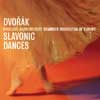Dvorák Slavonic Dances
With harnoncourt ‘nature’ and ‘nurture’ earn equal billing; fischer offers a fresh slant on tradition
View record and artist detailsRecord and Artist Details
Composer or Director: Antonín Dvořák
Genre:
Orchestral
Label: Teldec (Warner Classics)
Magazine Review Date: 7/2002
Media Format: CD or Download
Media Runtime: 73
Mastering:
Stereo
DDD
Catalogue Number: 8573-81038-2

Tracks:
| Composition | Artist Credit |
|---|---|
| (16) Slavonic Dances |
Antonín Dvořák, Composer
Antonín Dvořák, Composer Chamber Orchestra of Europe Nikolaus Harnoncourt, Conductor |
Author:
First‚ a simple test case: the Slavonic Dance No 15 in C‚ Op 72 No 7. Nikolaus Harnoncourt an the COE press forth with considerable energy. Note the gritty brass‚ the delicately tapered string figurations at 0'35" and then the lean but powerful crescendo back to opening idea. Chattering winds and trumpets enter at 0'55"; there’s the rustic thrust of middle and lower strings at 1'29" and then the clear textures and subtle nuances of the middle section (from 1'51"). Turn to Iván Fischer and the Budapest Festival Orchestra and although all the musical signposts remain securely in place‚ they’re not illuminated in quite the same way. Articulation has a lot to do with it‚ which in Harnoncourt’s case is more individual. But more about that later. What matters is that accent is precisely right‚ and the spirit too. Each dance on this exciting disc is granted its rightful‚ rustic character. The furiants really move (Harnoncourt’s readings of Op 46 Nos 1 and 8 are among the fastest on disc) and the Dumka of No 2 oscillates between tender reflection and feverish high spirits. The Mazurkalike Sousedská of No 6 dances along with disarming gracefulness (note the little nudge that animates the woodwind line at 0'12" and parallel expressive gestures thereafter) while the second Sko¶na (No 7) features lunging cellos (at 1'39"‚ anticipating the darkened reprise of the main theme a few moments later).
Harnoncourt’s high energy levels never precludes delicacy‚ or transparency or even the occasional suggestion of sentiment (as in Op 72 Nos 10 and 16). Tempo relations have been thought through to the last semiquaver though in general they’re more dramatic than Fischer’s. That Harnoncourt loves this music is beyond doubt‚ and that he understands it beyond question‚ but whether you actually prefer him to Fischer’s equally dedicated Hungarians is another matter. Compare them in the First Dance and the differences are amazing. Harnoncourt is bright and breathless‚ Fischer significantly broader and more emphatic‚ the timpani line being better defined. And in terms of overall style the two orchestras are worlds apart. The principal contrast is in the string playing‚ the COE all swelling curves and attenuated lines‚ with scant vibrato and an unforced mode of attack. Fischer’s band makes a beefier (as opposed to a louder) sound with discernible vibrato‚ even the odd suggestion of portamento. He‚ too‚ takes much care over detail‚ often characterising with great imagination. Sample the sizzling exchange between strings at 1'49" into No 5 or‚ in No 6‚ the contrast between the elegant opening (no hint of Harnoncourt’s Mazurkalike lilt here) and the sighing string lines of the response. Then there’s the twirling clarinet line at 1'14" into No 7 – a lovely touchÊ–Êwhich the COE in all their boisterousness rather lose sight of. Where Harnoncourt delves among Dvo·ák’s inner voices‚ pulling them to the fore like a magician freeing a rabbit‚ Fischer seems happier to let the music speak for itself. With him you’re less conscious of the different dance modes (which‚ as it happens‚ are extremely varied) and more aware of the essential continuity in Dvo·ák’s writing. In short‚ it’s more genial and as an interpretation I suppose more ‘conventional’. Which is why for the moment I find Harnoncourt’s disc the more absorbing of the two.
Whether in the long term he will appeal as much as Kubelík’s Bavarians or the Czechs under Talich and Sejna will depend on how you view local performing manners and sonorities. Kubelík brings a sense of narrative to the music (his Op 72 No 4 becomes an unforgettable tone poem)‚ Talich adds layers of affection and Sejna a breezy‚ clean cut quality that’s due in no small part to the birdlike characteristics of the Czech Phil woodwinds. All are wonderful and Fischer has evidently learned from them‚ or so it seems. And yet none are better played than the Chamber Orchestra of Europe CD where pooled individuality sheds fresh light on virtually every piece. If you don’t know the music‚ Harnoncourt will make you love it. And if you do know it‚ he’ll make you love it even more.
Discover the world's largest classical music catalogue with Presto Music.

Gramophone Digital Club
- Digital Edition
- Digital Archive
- Reviews Database
- Full website access
From £8.75 / month
Subscribe
Gramophone Full Club
- Print Edition
- Digital Edition
- Digital Archive
- Reviews Database
- Full website access
From £11.00 / month
Subscribe
If you are a library, university or other organisation that would be interested in an institutional subscription to Gramophone please click here for further information.




